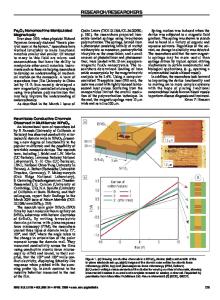Accordion-like composite of carbon-coated Fe 3 O 4 nanoparticle decorated Ti 3 C 2 MXene with enhanced electrochemical p
- PDF / 3,468,024 Bytes
- 11 Pages / 595.276 x 790.866 pts Page_size
- 81 Downloads / 286 Views
Accordion-like composite of carbon-coated Fe3O4 nanoparticle decorated Ti3C2 MXene with enhanced electrochemical performance Xiaoyi Wang1,2, Wenhao Chen3, Yulong Liao1,2,* Tianlong Wen2, and Zhiyong Zhong2
, Quanjun Xiang1, Yuanxun Li1,*,
1
Center for Applied Chemistry, University of Electronic Science and Technology of China, Chengdu 611731, China State Key Laboratory of Electronic Thin Film and Integrated Devices, University of Electronic Science and Technology of China, Chengdu 610054, China 3 Southwest China Institution of Electronic Technology, Chengdu 610036, China 2
Received: 30 April 2020
ABSTRACT
Accepted: 18 September 2020
MXene-based materials are considered to be promising candidates for electrodes in energy storage field owing to their features of two-dimensional layered structure, good conductivity, and chemical stability. Carbon-coated Fe3O4 nanoparticles (C@Fe3O4 NPs)-decorated Ti3C2 MXene composites were synthesized via a facile method for the first time. The prepared C@Fe3O4 NPs/Ti3C2 MXene composite was characterized by various techniques (XRD, SEM, TEM, TGA, and XPS), and the results showed that C@Fe3O4 NPs (diameter: 60 nm, layer thickness: 10 nm) were homogeneously distributed on the surfaces of Ti3C2 MXene interlayers while the accordion-like structure maintained. It is noted that the specific surface areas dramatically increased from 7.8 m2/g to 37.0 m2/g after introducing the nanoparticles. The C@Fe3O4 NPs/Ti3C2 MXene products exhibited a specific capacity of 231.5 mAh g-1 after 200 cycles under 100 mA/g when serving as anode materials for Li-ion batteries, which was markedly higher than that of pure Ti3C2 MXene (107.8 mAh g-1). This study presents and investigates a novel kind of MXene-based composite, which has the potential as electrode materials for energy storage.
Ó
Springer Science+Business
Media, LLC, part of Springer Nature 2020
Handling Editor: Dale Huber.
Address correspondence to E-mail: [email protected]; [email protected]
https://doi.org/10.1007/s10853-020-05362-3
J Mater Sci
GRAPHIC ABSTRACT
Introduction Two-dimensional (2D) materials have attracted extensive attention owing to their unique structures and are widely investigated for applications in various fields such as energy storage, sensor, and water splitting [1–4]. Recently, a new kind of 2D material, MXenes, which were first discovered by Naguib et al. [5], have aroused great interest among the researchers [5–7]. In general, MXenes are obtained with the assistance of hydrofluoric acid by etching the A layer of Mn?1AXn precursor (n = 1, 2, or 3), where M represents early transition metal elements (Ti, Zr, V, Nb, Ta, Mo, etc.), A represents Al and Si mostly, and X represents C or N [8]. Furthermore, the suffix of -ene is derived from the structural similarity compared with graphene. Correspondingly, a variety of MXenes have been prepared (Ti3C2, Mo2C, Ta4C3, Ti3CN, V2C, etc.), and they have shown great promise in electrochemical energy storage because of their outstanding properties including
Data Loading...











